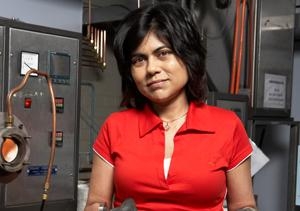Proving our mettle
OPINION: Innovation success comes to those who are persistent, writes the creator of 'green steel', Professor Veena Sahajwalla, in the Weekend Australian.
OPINION: Innovation success comes to those who are persistent, writes the creator of 'green steel', Professor Veena Sahajwalla, in the Weekend Australian.

OPINION: When I started my engineering degree, I was the only girl in my class. As socially isolating as it was at the time, I not only survived but I came out believing nothing could ever be as tough again. As it turned out, it was a great preparation for the challenges of innovation.
It’s never easy to imagine something entirely new, let alone prove it in the lab, then win the respect and acceptance of your scientific peers and go on to demonstrate that the idea not only works on an industrial, real world scale, but is commercially viable too.
Much is written about the Australia’s uneven innovation profile and the common failure to translate brilliance in the laboratory into patents and comparable commercial returns. Australia was ranked equal first in the world for university graduates (per capita) in 2010-2011 in the World Economic Forum’s Competitiveness Index, for example, but only 22nd in the world for innovation, despite consistently ranking above average within the OECD for the number of scientific papers published and the number of people with technical and research skills.
What does it take to an innovative idea into reality? My own personal goal was achieve industrial scale recycling. By that, I didn’t mean just taking out the yellow bins, although that’s important too. I wanted to “capture” industrial waste streams and re-cycle the huge volumes of waste we send to landfill back into industrial processing, and reduce emissions along the way. I wanted to turn waste into a valuable “resource”; that is, to transform waste from within, not just give rubbish a facelift.
The successful commercialisation of UNSW’s patented “green steel” making process goes back to 2003, when I had one of those rare “oh my God” moments in scientific research when you are looking at an experiment and it’s suddenly dawns on you that it’s actually working.
I had a camera set up to record through the quartz window of the lab furnace we were operating at over 1500° C. I knew I still had “to do the science” to demonstrate why this particular high temperature smelt was working, but I was already so excited I couldn’t sleep.
My proposition was that end-of-life polymers, or plastics, and tyres – both a huge burden for landfill sites -- could be used to substitute part of the fossil fuel load, in this case coke, used in electric arc furnace (EAF) steel-making.
But, that’s not all. I am researching carbon transformation, and lots of materials are carbon-based. The next step is to experiment with automotive waste for use as a resource in metals processing. In addition the use of agricultural waste in the built environment are examples of transformation of waste into valuable resource. More broadly, the creation of new, environmentally sustainable and commercially viable industrial processes and materials is the goal the SMaRT Centre at UNSW, which grew out of “green steel’s” commercial success.
It’s difficult to pick out one aspect of the innovation process which gets your across the line, because you can’t afford to trip up anywhere along the way. But, in getting “green steel” out onto the Australian and international market we needed an industrial partner. Our relationship with the large Australian steelmaker, Onesteel, and access to its Sydney furnaces for testing proved essential.
Our partnership with Onesteel continues to grow, and is extremely exciting for everyone involved the staff and students, and I get a thrill from creative thinking and from being part of such an amazing journey. Such a partnership needs to grow from mutual respect and understanding of each others needs regarding achieving our outcomes.
These partnerships lay the foundation for taking creative ideas through a journey into the commercial world. We need to understand our goals, and enjoy the journey!!
Innovation success comes to those who are persistent, and continue to dream of new concepts!!
Australia has the skills and research facilities to punch above its weight in innovation. But we need to think big and long term, so we already imagined the partners we will need to turn an innovation into a real world game changer, even before we hit those wonderful “OMG”moments in the lab.
Scientia Professor Veena Sahajwalla is the Director of UNSW's Centre for Sustainable Materials Research & Technology.
A version of this opinion piece was published in the Weekend Australian.